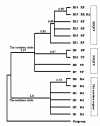Phylogeographic analysis reveals significant spatial genetic structure of Incarvillea sinensis as a product of mountain building
- PMID: 22546007
- PMCID: PMC3447706
- DOI: 10.1186/1471-2229-12-58
Phylogeographic analysis reveals significant spatial genetic structure of Incarvillea sinensis as a product of mountain building
Abstract
Background: Incarvillea sinensis is widely distributed from Southwest China to Northeast China and in the Russian Far East. The distribution of this species was thought to be influenced by the uplift of the Qinghai-Tibet Plateau and Quaternary glaciation. To reveal the imprints of geological events on the spatial genetic structure of Incarvillea sinensis, we examined two cpDNA segments ( trnH- psbA and trnS- trnfM) in 705 individuals from 47 localities.
Results: A total of 16 haplotypes was identified, and significant genetic differentiation was revealed (GST =0.843, NST = 0.975, P < 0.05). The survey detected two highly divergent cpDNA lineages connected by a deep gap with allopatric distributions: the southern lineage with higher genetic diversity and differentiation in the eastern Qinghai-Tibet Plateau, and the northern lineage in the region outside the Qinghai-Tibet Plateau. The divergence between these two lineages was estimated at 4.4 MYA. A correlation between the genetic and the geographic distances indicates that genetic drift was more influential than gene flow in the northern clade with lower diversity and divergence. However, a scenario of regional equilibrium between gene flow and drift was shown for the southern clade. The feature of spatial distribution of the genetic diversity of the southern lineage possibly indicated that allopatric fragmentation was dominant in the collections from the eastern Qinghai-Tibet Plateau.
Conclusions: The results revealed that the uplift of the Qinghai-Tibet Plateau likely resulted in the significant divergence between the lineage in the eastern Qinghai-Tibet Plateau and the other one outside this area. The diverse niches in the eastern Qinghai-Tibet Plateau created a wide spectrum of habitats to accumulate and accommodate new mutations. The features of genetic diversity of populations outside the eastern Qinghai-Tibet Plateau seemed to reveal the imprints of extinction during the Glacial and the interglacial and postglacial recolonization. Our study is a typical case of the significance of the uplift of the Qinghai-Tibet Plateau and the Quaternary Glacial in spatial genetic structure of eastern Asian plants, and sheds new light on the evolution of biodiversity in the Qinghai-Tibet Plateau at the intraspecies level.
Figures




References
-
- Ge XJ, Chiang YC, Chou CH, Chiang TY. Nested clade analysis of Dunnia sinensis (Rubiaceae), a monotypic genus from China based on organelle DNA sequences. Conserv Genet. 2002;3:351–362. doi: 10.1023/A:1020579617678. - DOI
-
- Hamrick JL, Godt MJW, Sherman-Broyles SL. Factors influencing levels of genetic diversity in woody plant species. New Forest. 1992;6:95–124. doi: 10.1007/BF00120641. - DOI
-
- Avise JC. Phylogeography: The History and Formation of Species. Harvard University Press, Cambridge, Massachusetts; 2000.
Publication types
MeSH terms
Substances
Associated data
- Actions
- Actions
- Actions
- Actions
- Actions
- Actions
- Actions
- Actions
- Actions
- Actions
- Actions
- Actions
- Actions
- Actions
- Actions
- Actions
- Actions
- Actions
- Actions
- Actions
LinkOut - more resources
Full Text Sources
Research Materials
Miscellaneous

